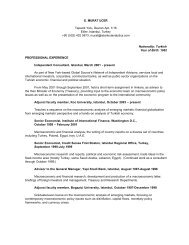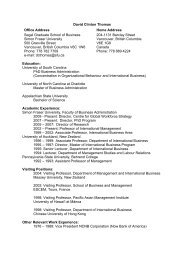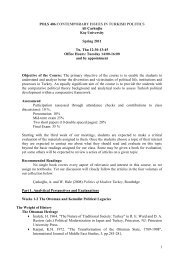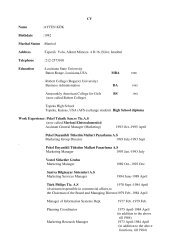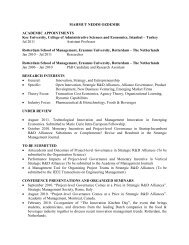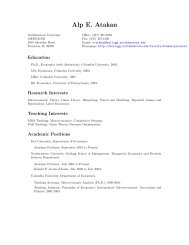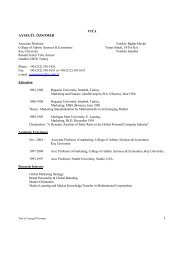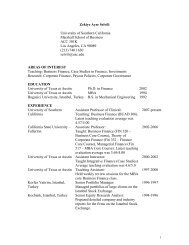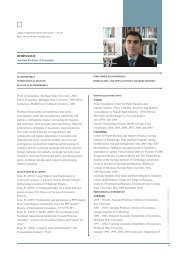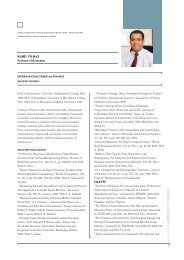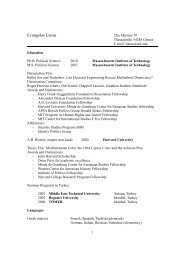You also want an ePaper? Increase the reach of your titles
YUMPU automatically turns print PDFs into web optimized ePapers that Google loves.
<strong>ECON</strong> <strong>360</strong> <strong>Money</strong> <strong>and</strong> <strong>Banking</strong> <strong>Fall</strong> <strong>2012</strong>Instructor:Class Meets:Office Hours:Class Web-site:Selva DemiralpCASE 243Phone: x1842, e-mail: sdemiralp@ku.edu.trKUAISCourse Goals:This course aims to describe the conduct of monetary policy, provide an introduction to thealternative theories regarding the impact of monetary policy, <strong>and</strong> describe the role <strong>and</strong> theevolution of money, banks, <strong>and</strong> other financial institutions. The course focuses on financialmarkets <strong>and</strong> financial intermediaries with special emphasis on the role of the central bank.Among the most important players in financial markets are the central banks, which are thegovernment authorities in charge of monetary policy. Central banks’ actions affect interestrates, the amount of credit, <strong>and</strong> the money supply, all of which have direct effects not only onfinancial markets, but also on aggregate output <strong>and</strong> inflation. Hence, by studying thefunctions of a central bank, students should be able to comprehend the forces behindmonetary policy decisions, be able to follow current news about the monetary policy actions,<strong>and</strong> develop an assessment of the impact of policy actions on the overall economy.Textbook:Frederic S. Mishkin, The Economics of <strong>Money</strong>, <strong>Banking</strong>, <strong>and</strong> Financial Markets, 8 th edition,Harper-Collins. The book is very well written <strong>and</strong> I encourage you to study it very carefully.Complementary Reading:The following online publications are also very helpful, which provide the insiders’ view onthe mechanics of U.S. monetary policy:1) The Federal Reserve System: Purposes <strong>and</strong> Functionshttp://www.federalreserve.gov/pf/pf.htm2) Ann Marie Meulendyke (1998), U.S. Monetary Policy <strong>and</strong> Financial Marketshttp://www.newyorkfed.org/education/addpub/monpol/Additional Resources:The Central Bank of the Republic of Turkey maintains a useful website of Turkish economicdata as well as links to monetary policy reports <strong>and</strong> research papers(http://www.tcmb.gov.tr/). For the U.S., Board of Governors provides the correspondinginformation on their website (www.federalreserve.gov) with links to the Federal ReserveEducation web site. I recommend that you visit both of these websites in strengthening yourunderst<strong>and</strong>ing of monetary policy.Course Grading:Quizzes 15%Midterm 1 40%Midterm 2 45%1
QuizzesThe quizzes are heavily based on end of chapter problems. The answers for the end ofchapter problems will be posted on the web. In addition to the end of chapter problems, I mayassign a news article that is related to the topics covered in class (depending on theavailability of such articles). In that case, the quiz will be based on your critical evaluation ofa newspaper/magazine article. I will post the article in advance <strong>and</strong> this way you will have achance to read the article before the quiz. However you will not know the specific questionthat will be asked based on that article. You will be evaluated based on your depth of analysisin linking the article to the material covered in class <strong>and</strong> your original insight.There will approximately be five quizzes (the number may change). The idea is to encourageyou to study on a regular basis <strong>and</strong> work on the problem sets promptly. You will be notifiedin advance of a quiz. There is no make up for the quizzes but I will drop the quiz with theminimum score.Other ExamsThere will be two midterm examinations. The second midterm will be given on the last dayof classes.Other InformationIf you miss one of the exams due to health reasons (provided that you have a valid doctor’sreport) you will be given a make up exam at the end of the semester. There is only ONEmake up exam for both midterms <strong>and</strong> it is cumulative. Do not miss the regularly scheduledmidterm unless you are seriously sick on the exam date. You will be punishing yourselfseverely because make-up questions are designed to be MORE DIFFICULT in order to befair to your peers.Course Outline:1. Introduction: An Overview (chs. 1-3)2. Supply <strong>and</strong> Dem<strong>and</strong> in the Market for <strong>Money</strong> (ch. 5, pp. 111-121)3. Financial Institutions (chs. 8-9)4. Central <strong>Banking</strong> <strong>and</strong> the Conduct of Monetary Policy (chs. 12-16)5. Monetary Theory (chs. 19, 23)Academic Honesty:The following note summarizes the faculty’s position on Academic Honesty:“Honesty <strong>and</strong> trust are important to all of us as individuals. Students <strong>and</strong> faculty adhere to thefollowing principles of academic honesty at Koc University:1. Individual accountability for all individual work, written or oral. Copying from othersor providing answers or information, written or oral, to others is cheating.2. Providing proper acknowledgement of original author. Copying from anotherstudent’s paper or from another text without written acknowledgement is plagiarism.3. Authorized teamwork. Unauthorized help from another person or having someone elsewrite one’s paper or assignment is collusion.Cheating, plagiarism, <strong>and</strong> collusion are serious offenses resulting in an F grade <strong>and</strong>disciplinary action.”2



